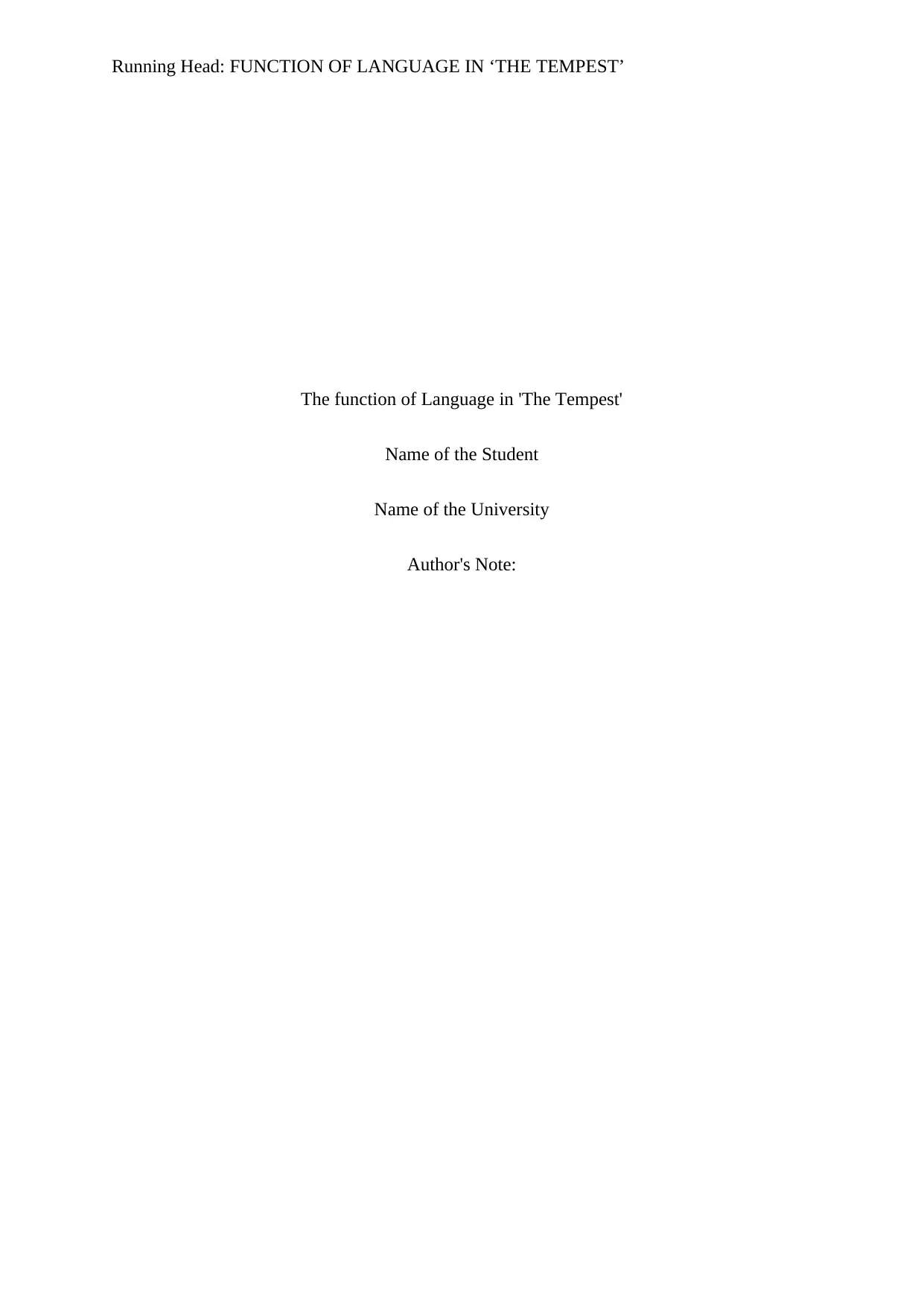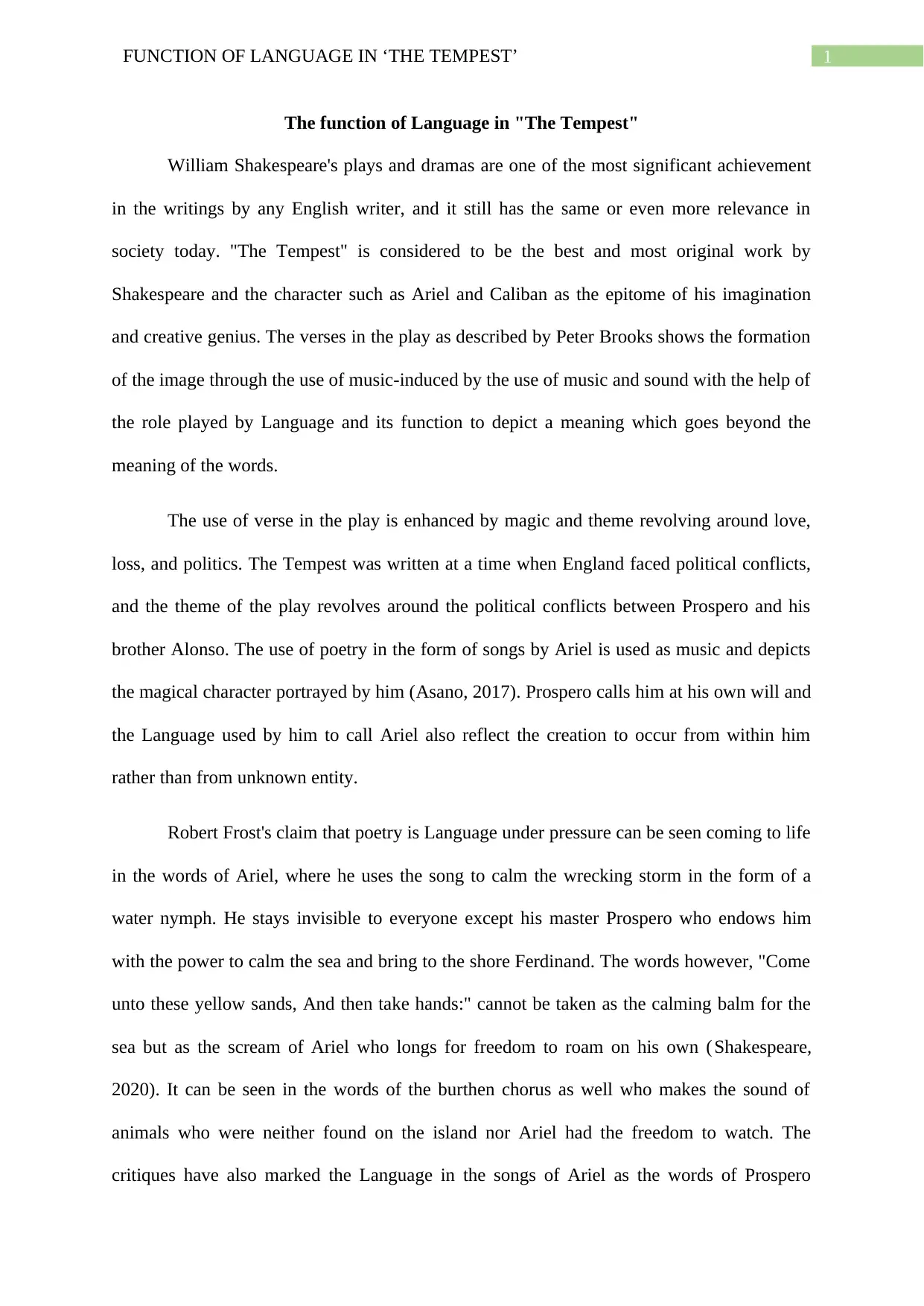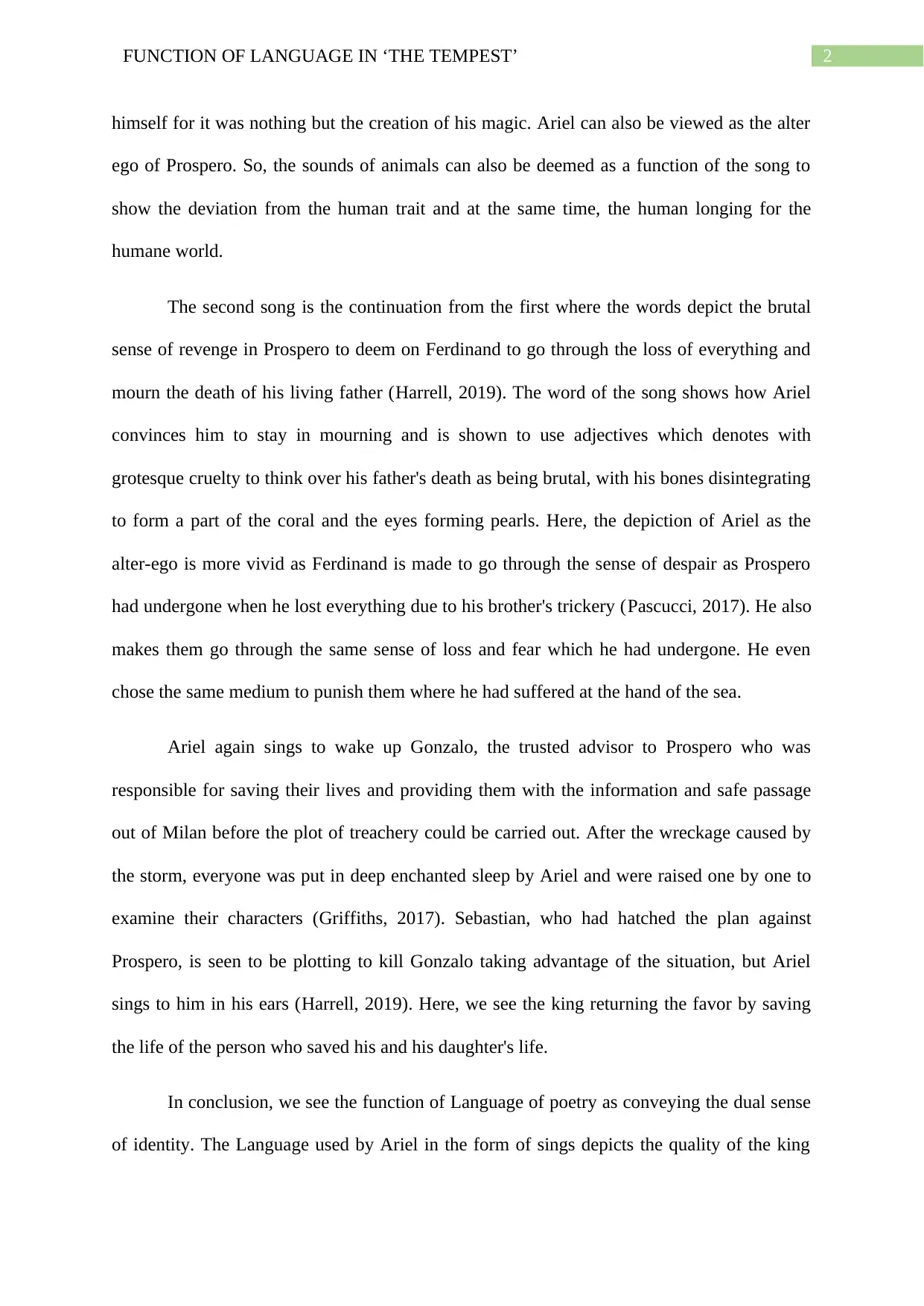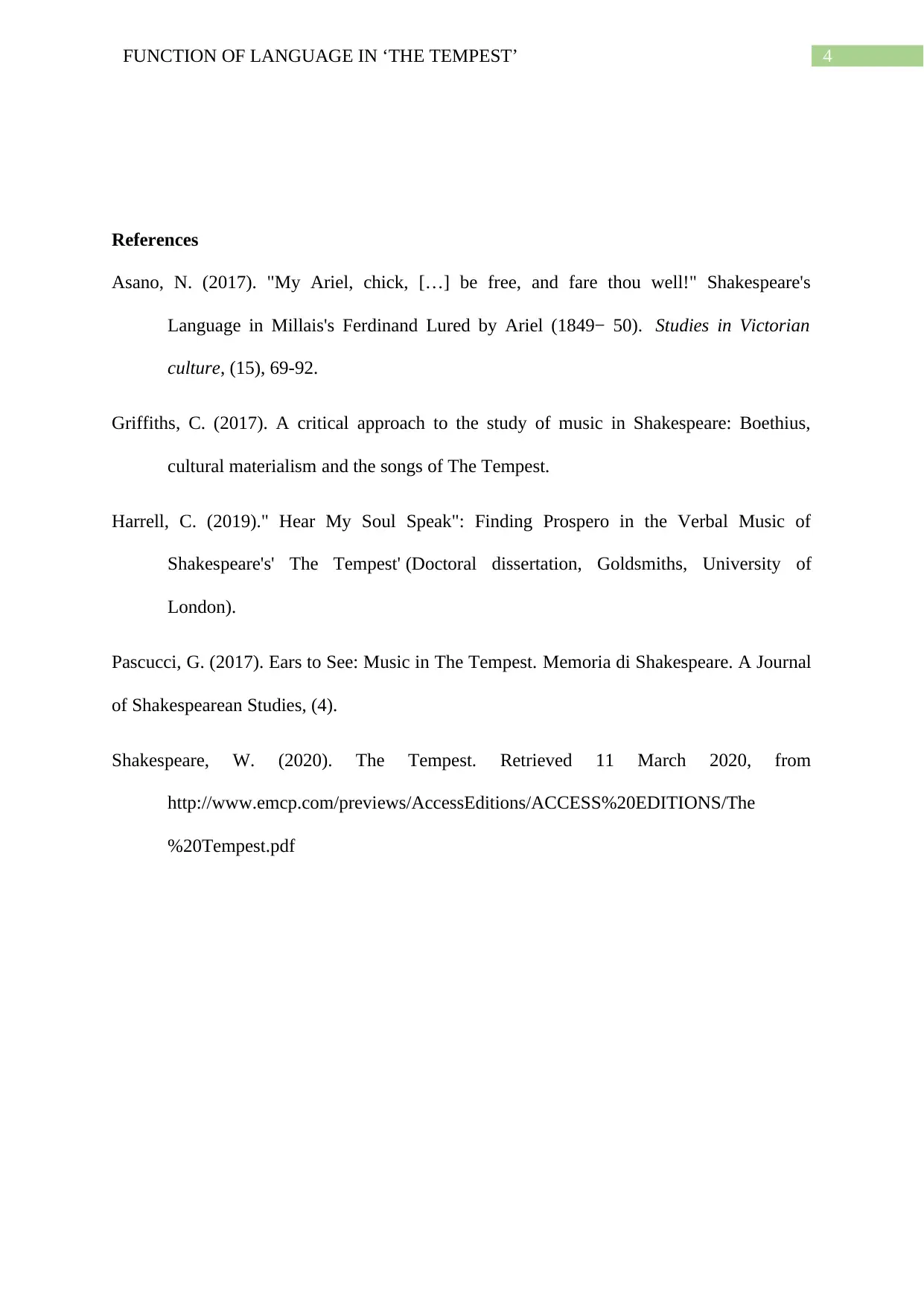Analyzing the Function of Language in Shakespeare's 'The Tempest'
VerifiedAdded on 2022/08/11
|5
|1142
|18
Essay
AI Summary
This essay examines the multifaceted function of language in William Shakespeare's 'The Tempest'. It focuses on the significance of poetry and songs, particularly those delivered by the character Ariel, in conveying complex themes such as power, revenge, and reconciliation. The analysis highlights how Shakespeare uses language to create vivid imagery, explore the dual nature of identity, and reflect the political and emotional conflicts within the play. The essay emphasizes the role of Ariel's songs in manipulating characters and advancing the plot, ultimately illustrating how language serves as a powerful tool for shaping meaning and driving the narrative. Furthermore, the essay touches upon the historical context of the play, connecting the themes of language with the political assertions of Shakespeare's time, and the use of language in the masque at the end of the play to celebrate love and family.

Running Head: FUNCTION OF LANGUAGE IN ‘THE TEMPEST’
The function of Language in 'The Tempest'
Name of the Student
Name of the University
Author's Note:
The function of Language in 'The Tempest'
Name of the Student
Name of the University
Author's Note:
Paraphrase This Document
Need a fresh take? Get an instant paraphrase of this document with our AI Paraphraser

1FUNCTION OF LANGUAGE IN ‘THE TEMPEST’
The function of Language in "The Tempest"
William Shakespeare's plays and dramas are one of the most significant achievement
in the writings by any English writer, and it still has the same or even more relevance in
society today. "The Tempest" is considered to be the best and most original work by
Shakespeare and the character such as Ariel and Caliban as the epitome of his imagination
and creative genius. The verses in the play as described by Peter Brooks shows the formation
of the image through the use of music-induced by the use of music and sound with the help of
the role played by Language and its function to depict a meaning which goes beyond the
meaning of the words.
The use of verse in the play is enhanced by magic and theme revolving around love,
loss, and politics. The Tempest was written at a time when England faced political conflicts,
and the theme of the play revolves around the political conflicts between Prospero and his
brother Alonso. The use of poetry in the form of songs by Ariel is used as music and depicts
the magical character portrayed by him (Asano, 2017). Prospero calls him at his own will and
the Language used by him to call Ariel also reflect the creation to occur from within him
rather than from unknown entity.
Robert Frost's claim that poetry is Language under pressure can be seen coming to life
in the words of Ariel, where he uses the song to calm the wrecking storm in the form of a
water nymph. He stays invisible to everyone except his master Prospero who endows him
with the power to calm the sea and bring to the shore Ferdinand. The words however, "Come
unto these yellow sands, And then take hands:" cannot be taken as the calming balm for the
sea but as the scream of Ariel who longs for freedom to roam on his own ( Shakespeare,
2020). It can be seen in the words of the burthen chorus as well who makes the sound of
animals who were neither found on the island nor Ariel had the freedom to watch. The
critiques have also marked the Language in the songs of Ariel as the words of Prospero
The function of Language in "The Tempest"
William Shakespeare's plays and dramas are one of the most significant achievement
in the writings by any English writer, and it still has the same or even more relevance in
society today. "The Tempest" is considered to be the best and most original work by
Shakespeare and the character such as Ariel and Caliban as the epitome of his imagination
and creative genius. The verses in the play as described by Peter Brooks shows the formation
of the image through the use of music-induced by the use of music and sound with the help of
the role played by Language and its function to depict a meaning which goes beyond the
meaning of the words.
The use of verse in the play is enhanced by magic and theme revolving around love,
loss, and politics. The Tempest was written at a time when England faced political conflicts,
and the theme of the play revolves around the political conflicts between Prospero and his
brother Alonso. The use of poetry in the form of songs by Ariel is used as music and depicts
the magical character portrayed by him (Asano, 2017). Prospero calls him at his own will and
the Language used by him to call Ariel also reflect the creation to occur from within him
rather than from unknown entity.
Robert Frost's claim that poetry is Language under pressure can be seen coming to life
in the words of Ariel, where he uses the song to calm the wrecking storm in the form of a
water nymph. He stays invisible to everyone except his master Prospero who endows him
with the power to calm the sea and bring to the shore Ferdinand. The words however, "Come
unto these yellow sands, And then take hands:" cannot be taken as the calming balm for the
sea but as the scream of Ariel who longs for freedom to roam on his own ( Shakespeare,
2020). It can be seen in the words of the burthen chorus as well who makes the sound of
animals who were neither found on the island nor Ariel had the freedom to watch. The
critiques have also marked the Language in the songs of Ariel as the words of Prospero

2FUNCTION OF LANGUAGE IN ‘THE TEMPEST’
himself for it was nothing but the creation of his magic. Ariel can also be viewed as the alter
ego of Prospero. So, the sounds of animals can also be deemed as a function of the song to
show the deviation from the human trait and at the same time, the human longing for the
humane world.
The second song is the continuation from the first where the words depict the brutal
sense of revenge in Prospero to deem on Ferdinand to go through the loss of everything and
mourn the death of his living father (Harrell, 2019). The word of the song shows how Ariel
convinces him to stay in mourning and is shown to use adjectives which denotes with
grotesque cruelty to think over his father's death as being brutal, with his bones disintegrating
to form a part of the coral and the eyes forming pearls. Here, the depiction of Ariel as the
alter-ego is more vivid as Ferdinand is made to go through the sense of despair as Prospero
had undergone when he lost everything due to his brother's trickery (Pascucci, 2017). He also
makes them go through the same sense of loss and fear which he had undergone. He even
chose the same medium to punish them where he had suffered at the hand of the sea.
Ariel again sings to wake up Gonzalo, the trusted advisor to Prospero who was
responsible for saving their lives and providing them with the information and safe passage
out of Milan before the plot of treachery could be carried out. After the wreckage caused by
the storm, everyone was put in deep enchanted sleep by Ariel and were raised one by one to
examine their characters (Griffiths, 2017). Sebastian, who had hatched the plan against
Prospero, is seen to be plotting to kill Gonzalo taking advantage of the situation, but Ariel
sings to him in his ears (Harrell, 2019). Here, we see the king returning the favor by saving
the life of the person who saved his and his daughter's life.
In conclusion, we see the function of Language of poetry as conveying the dual sense
of identity. The Language used by Ariel in the form of sings depicts the quality of the king
himself for it was nothing but the creation of his magic. Ariel can also be viewed as the alter
ego of Prospero. So, the sounds of animals can also be deemed as a function of the song to
show the deviation from the human trait and at the same time, the human longing for the
humane world.
The second song is the continuation from the first where the words depict the brutal
sense of revenge in Prospero to deem on Ferdinand to go through the loss of everything and
mourn the death of his living father (Harrell, 2019). The word of the song shows how Ariel
convinces him to stay in mourning and is shown to use adjectives which denotes with
grotesque cruelty to think over his father's death as being brutal, with his bones disintegrating
to form a part of the coral and the eyes forming pearls. Here, the depiction of Ariel as the
alter-ego is more vivid as Ferdinand is made to go through the sense of despair as Prospero
had undergone when he lost everything due to his brother's trickery (Pascucci, 2017). He also
makes them go through the same sense of loss and fear which he had undergone. He even
chose the same medium to punish them where he had suffered at the hand of the sea.
Ariel again sings to wake up Gonzalo, the trusted advisor to Prospero who was
responsible for saving their lives and providing them with the information and safe passage
out of Milan before the plot of treachery could be carried out. After the wreckage caused by
the storm, everyone was put in deep enchanted sleep by Ariel and were raised one by one to
examine their characters (Griffiths, 2017). Sebastian, who had hatched the plan against
Prospero, is seen to be plotting to kill Gonzalo taking advantage of the situation, but Ariel
sings to him in his ears (Harrell, 2019). Here, we see the king returning the favor by saving
the life of the person who saved his and his daughter's life.
In conclusion, we see the function of Language of poetry as conveying the dual sense
of identity. The Language used by Ariel in the form of sings depicts the quality of the king
⊘ This is a preview!⊘
Do you want full access?
Subscribe today to unlock all pages.

Trusted by 1+ million students worldwide

3FUNCTION OF LANGUAGE IN ‘THE TEMPEST’
who had command over his subject, and the same character is shown by the songs being sung
at the point where he wants his commands to be followed. Shakespearian plays especially his
comedies show a particular affinity towards poetries and songs which can be traced back to
the change of political assertion on him. The masque at the end of the play in celebration of
the marriage ceremony of Ferdinand and Miranda depicts the use of Language to show the
liberation of the emotion of love and family and the restoration of the family.
who had command over his subject, and the same character is shown by the songs being sung
at the point where he wants his commands to be followed. Shakespearian plays especially his
comedies show a particular affinity towards poetries and songs which can be traced back to
the change of political assertion on him. The masque at the end of the play in celebration of
the marriage ceremony of Ferdinand and Miranda depicts the use of Language to show the
liberation of the emotion of love and family and the restoration of the family.
Paraphrase This Document
Need a fresh take? Get an instant paraphrase of this document with our AI Paraphraser

4FUNCTION OF LANGUAGE IN ‘THE TEMPEST’
References
Asano, N. (2017). "My Ariel, chick, […] be free, and fare thou well!" Shakespeare's
Language in Millais's Ferdinand Lured by Ariel (1849− 50). Studies in Victorian
culture, (15), 69-92.
Griffiths, C. (2017). A critical approach to the study of music in Shakespeare: Boethius,
cultural materialism and the songs of The Tempest.
Harrell, C. (2019)." Hear My Soul Speak": Finding Prospero in the Verbal Music of
Shakespeare's' The Tempest' (Doctoral dissertation, Goldsmiths, University of
London).
Pascucci, G. (2017). Ears to See: Music in The Tempest. Memoria di Shakespeare. A Journal
of Shakespearean Studies, (4).
Shakespeare, W. (2020). The Tempest. Retrieved 11 March 2020, from
http://www.emcp.com/previews/AccessEditions/ACCESS%20EDITIONS/The
%20Tempest.pdf
References
Asano, N. (2017). "My Ariel, chick, […] be free, and fare thou well!" Shakespeare's
Language in Millais's Ferdinand Lured by Ariel (1849− 50). Studies in Victorian
culture, (15), 69-92.
Griffiths, C. (2017). A critical approach to the study of music in Shakespeare: Boethius,
cultural materialism and the songs of The Tempest.
Harrell, C. (2019)." Hear My Soul Speak": Finding Prospero in the Verbal Music of
Shakespeare's' The Tempest' (Doctoral dissertation, Goldsmiths, University of
London).
Pascucci, G. (2017). Ears to See: Music in The Tempest. Memoria di Shakespeare. A Journal
of Shakespearean Studies, (4).
Shakespeare, W. (2020). The Tempest. Retrieved 11 March 2020, from
http://www.emcp.com/previews/AccessEditions/ACCESS%20EDITIONS/The
%20Tempest.pdf
1 out of 5
Your All-in-One AI-Powered Toolkit for Academic Success.
+13062052269
info@desklib.com
Available 24*7 on WhatsApp / Email
![[object Object]](/_next/static/media/star-bottom.7253800d.svg)
Unlock your academic potential
Copyright © 2020–2025 A2Z Services. All Rights Reserved. Developed and managed by ZUCOL.